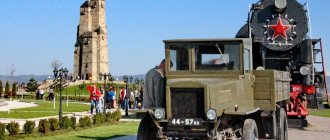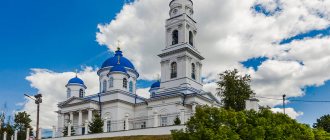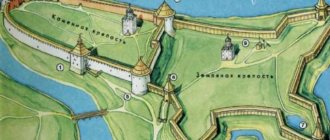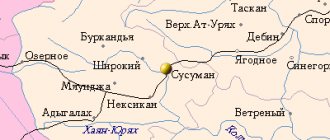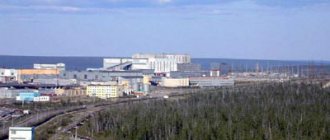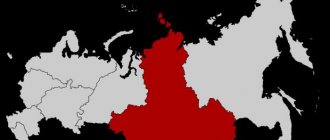There is something futuristic about Magas. This is not connected with the architecture, which is extremely ordinary and represents a triumph of the “Luzhkov style” over the ancient traditions of architecture in Ingushetia. This is roughly what the new courts in Moscow look like, or, for example, the Fundamental Library of Moscow State University and district administrations. It's about the general atmosphere, not the architecture. The capital of Ingushetia, which has no history, looks strange and unusual. One gets the impression that you are in an experimental sterile laboratory that works for one purpose: forward, into the future.
Population, main buildings
The capital of Ingushetia has been steadily moving towards the future, starting in 1995, and since 2000 - and in the status of the capital, already official. During this time, the city grew in length by 4 km, and in width by 3 km, and also acquired a population (in Magas in 2012 about 5 thousand people live permanently, and more recently, at the beginning of 2010, its population was only 524 resident). About 5-6 thousand more people come here every day to work. About 90% of all republican government institutions are located in this city, including the residence of the president, ministries and parliament, as well as small units of the administrative apparatus. The Ingush State University is also located here, and a television building was completed for the twentieth anniversary of the founding of the republic. The capital of Ingushetia also has its own republican bank, and the business center has recently begun to actively develop.
Guide
Cities of the Republic of Ingushetia
Nazran.
“Nana Nasare”, or Nazran, is the former administrative center of the Republic of Ingushetia and its largest city with a population of more than 120 thousand people. It is located on land where human settlements have lived since ancient times, but despite its centuries-old history, the official founding date is considered to be 1781 - it was then that Nazran was marked by Russian Lieutenant Colonel L. Steder on the map. Nazran is an ancient Ingush city that attracts tourists not only with its original attractions, but also with the opportunity to bring home unique souvenirs. We are talking about exotic products made from fish skin, produced at a local factory, the likes of which cannot be found anywhere in Russia. These include shoes made of carp, purses made of salmon, sturgeon vases, and trout handbags. The method of producing goods from such an unusual material was invented and patented by local entrepreneurs. The craftsmen of Nazran will also offer their guests to purchase national burkas and hats, delicious Ingush honey, stunningly beautiful handmade carpets and excellent examples of Caucasian edged weapons. But it’s better to stock up on souvenirs after exploring the main attractions of the city and its surroundings.
Nazran is a very old city, with its own set of authentic attractions and unique flavor. There is definitely something to see and admire here. For example, the famous Gamurzievskoye settlement - the place where the Nazran fortress was located, and the Borg Kash mausoleum. The settlement is not a beautiful historical structure, but within the framework of archeology and history it is simply priceless. Another major attraction of Nazran is its fortress, built in the 19th century, with which many of the most important events in the life of the Ingush people are connected.
Today, unfortunately, only ruins remain of the once grandiose structure. But even in them you can discern the centuries-old history of the city, built in the best traditions of fortification architecture.
Malgobek - City of military glory.
Malgobek is the administrative center of the Malgobek district of the Republic of Ingushetia, the population is more than 40 thousand people. The city of oil workers - Malgobek was founded in 1933 in connection with the discovery of the Malgobek oil field, located in the Alkhanchurt valley, on the southern slopes of the Tersky Range, 65 km northwest of the republican center - the city of Magas.
The heroic pages of the history of Malgobek are associated with the period of the Great Patriotic War. Since the beginning of the Great Patriotic War, many Malgobek residents went to the front to defend their Motherland, and the remaining residents - home front workers - worked around the clock for the needs of the front, extracting oil, which was very necessary for the defense of the country.
The enemy was rapidly advancing towards the Caucasus. At the headquarters of our army, intense work was carried out to draw up plans for the defense of the oil regions of the Caucasus from the approaching enemy. In the summer of 1942, German troops, during fierce battles, approached the oil regions of Checheno-Ingushetia near the city of Malgobek. Fierce battles near Malgobek lasted for more than four months. The outcome of the Malgobek defensive operation had a very serious impact on the results of military operations on the entire Transcaucasian front. In this operation, our troops defeated the first tank army and thwarted the plan of the Nazi command to capture the Grozny and Baku oil regions. On October 8, 2007, in memory of the courage, fortitude, and heroism shown by the city’s defenders during the Great Patriotic War, by Decree of the President of the Russian Federation, Malgobek was awarded the honorary title of the Russian Federation “City of Military Glory.”
Karabulak.
The city is located on the left bank of the Sunzha River, in the central part of the Republic of Ingushetia. The population is more than 35.5 thousand people. The history of this settlement began in the 18th century. On the site of the city was the village of Eldarkhan-Gala (“Eldarkhan’s fortress”), created by one of the Ingush societies, the Orstkhoys, and destroyed at the end of the 18th century. In the next century, a Russian guard fortification was built in its place, which over time turned into the Cossack village of Karabulakskaya, which in 1860 became part of the Sunzhensky department in the Terek region. In 1920-1929 The village was part of the Sunzhensky Cossack district, and in 1962 it was transformed into an urban-type settlement under the control of the Sunzhensky District Council of the Chechen-Ingush Autonomous Soviet Socialist Republic. In 1995, Karabulak received city status. The subsoil of Karabulak is rich in oil reserves; the Ingushneftegazprom enterprise is developing it. The chemical industry is developing in the city; Khimreagent operates on its territory, as well as the largest flour-grinding complex in Russia.
The city is home to 35.5 thousand people, the majority of whom are Ingush. The city is home to one of the three Orthodox churches in Ingushetia - the Church of the Kazan Icon of the Mother of God.
The Sunzha River, flowing through the territory of Karabulak, is the largest river in Ingushetia. This is the main natural attraction of the area. In some places the flow of the Sunzha is measured and calm, but in some areas it turns into a seething and raging mountain river. The Sunzhensky ridge stretches 11 kilometers from Karabulak. Its highest point, Mount Karabulak, is located precisely in the city area. The height of the mountain above sea level is 715 meters. The city also has a pond, where locals and visitors can walk at any time of the year.
Karabulak is located in the continental climate zone. Winter here is short and mild (the average temperature in January is plus 5 degrees), thaws and precipitation in the form of rain and sleet are frequent. Summer is warm (+21C in July) with short showers and thunderstorms.
To the south of Karabulak there is the federal highway M29 "Caucasus", to the north is the railway line of the North Caucasus Railway (Beslan-Sleptsovskaya section), on the northern outskirts of the city there is the Karabulaksky railway crossing.
Sunzha.
In the late 20s - early 30s of the 19th century, the Ingush were evicted to the plain through the Assinsky gorge, Ingush villages were founded in the lower reaches of the Assa and along the banks of the Sunzha within the current Sunzha region of Ingushetia. On the map of 1834, there is a whole network of Ingush settlements in these places. The village of Korey was located in the area of the modern city of Sunzha. In the report of the Vladikavkaz commandant Shiroky dated December 31, 1838, it is designated as Kurei-Yurt. According to this report, there were 105 households in the village and 585 people lived. For that time it was a fairly large settlement. Also, on the “Map of the Left Flank of the Caucasian Line” of 1840, this village is designated as Korey-Yurt
The founder of the village of Kuri-Yurt (Ingush. КIuri-Yurt) in the area of the modern city of Sunzha is called Kuri, the son of Ali (Ingush. Iаьлий КIuri), from the village of Leymi, from where he moved to Sunzha in the late 20s or early 30s XIX century. The descendants of Kuri Aliyev, according to some sources, now live in the village of Barsuki and bear the surname Kuriev. It is alleged that the village of Kuri-Yurt existed until 1845. Later German and British maps of 1855 clearly show that the village of Korei was located on the right (southern) bank of the Sunzha and therefore was not the direct predecessor of the Cossack village founded later. Sunzha (until 2016 - Ordzhonikidzevskaya) is a city of republican significance, the administrative center of the Sunzha district of Ingushetia.
The city is located in the Sunzha valley, 22 km northeast of Nazran, 47 km west of Grozny (distance by road).
The historical core is located on the left (northern) bank, but currently residential buildings are spread out on both sides of the river.. Sunzha is the newest city in Ingushetia. The population is about 65 thousand people who work at several enterprises in the city. By the way, it was in Sunzha that the Ingush State University was opened. Transport communication of the Republic of Ingushetia.
1. Bus station in Nazran.
The new bus station is located in Nazran. This is the largest bus station in the North Caucasus District, with an area of more than 1000 sq.m. On the territory of the bus station there is a hotel, a cafe, mother and child rooms, driver rest areas, and a storage room. The bus station serves intraregional and interregional flights, and it is planned to launch international flights. Address: 386140, Russia, Republic of Ingushetia, Nazran, st. Bakinskaya, 89. Phone: +7 (873) 222-48-66.
2. Magas Airport named after. Oskanova S.S.
Magas Airport named after. Oskanova S.S. located in Sunzhensky district, village. Ordzhonikidzevskaya. Address: 386245, Russia, Republic of Ingushetia, Sunzha, st. Kalinina, 5Telephone.
3. Nazran railway station.
The station building houses halls of increased comfort, a spacious waiting room, long rest rooms, several ticket offices, an information service, a room for mothers and children, a luggage compartment for storing luggage, as well as buffets and cafeterias. Address: 386102, Russia, Republic of Ingushetia, Nazran, st. Pobeda, 1. Phones, +7 (8732) 22-19-19.
Projects under construction
The future tense, which dominates the news from this city, also adds futurism. They mainly talk about the dates when it is planned to open the objects under construction today: the Drama Theatre, the Cathedral Mosque, the diagnostic center, the House of Friendship of the Peoples of the North Caucasus, schools, a business center, residential buildings, kindergartens and other buildings. The feeling of sterility is reinforced not only by the cleanliness and newness of the city streets, but also by the absence of any industry. Factories, factories and agricultural enterprises are not built here as a matter of principle.
Some features of the city
Magas is a city of students sitting with laptops during breaks between classes on the Alley of the Republic, officials and a few schoolchildren dressed in smart uniforms. Clumsy signs, noisy markets, crowds - you will find all this in Nazran, checkpoints are located in border areas and gorges, history and ancient architecture are in the mountainous, southern part of the republic. This city had the honor of being an ideal settlement, like those that were built in the last century by Soviet citizens with great enthusiasm, who at the same time dreamed of building a new life. Let's hope that Ingushetia (the republic whose capital we are describing) will be no less understandable, open and, most importantly, calm than its main city today.
Nazran
We passed the outskirts of Nazran almost without seeing the city itself.
But we made a half-hour stop at the memorial complex commemorating the 70th anniversary of the deportation of Ingush and Chechens. I made a separate post about it, you can read it here.
We drive further, next to the memorial complex there is an Amphitheater.
Ice Arena "ERZI".
Mound of ancestors "Abi-Guv".
City of Nazran.
Secondary school No. 6.
Nazran is the largest city in Ingushetia with a population of about 100 thousand people and is not the official capital of the republic.
A few more photos of Nazran from the window of our minibus.
This is the end of the flat foothills of Ingushetia, which we covered with all the stops in less than an hour. Next was Chechnya.
Train station and airport
The airport of the same name is located 30 km from Magas, and the railway station is located eight kilometers from the city, in Nazran. The capital of Ingushetia is located on the Caucasus (federal) highway, so in terms of transport everything is quite convenient. You can get around the city by minibus or bus, but walking is easier - the distances are very short. Sunzha, a mountain river, flows near Magas. The former capital of Ingushetia, Nazran, located nearby, is also located on this river.
Literature
- Dolgieva M.B., Kartoev M.M., Kodzoev N.D., Matiev T.Kh.
History of Ingushetia. — 4th ed. - Rostov-on-Don: Southern Publishing House, 2013. - Kodzoev N.D.
[www.liveinternet.ru/community/2411429/post80498386/ Location and meaning of the name of the Alan capital of the city of Magas] (Russian) // Bulletin of the Archaeological Center. - Nazran, 2001. - Issue. 1. - pp. 43-52. - Kodzoev N.D.
Archaeological monuments of Magas (Russian) // Bulletin of the Archaeological Center. - Nazran, 2001. - Issue. 1. - pp. 80-81.
What may be of interest to tourists
There are very few Russian residents in the city; the overwhelming majority of the population are Ingush. Magas, the capital of Ingushetia, does not yet have a mosque. It is planned, however, to complete the construction of the Cathedral Mosque by 2016, as well as a spiritual center along with a madrasah and a number of other institutions.
The city can be quite noisy during the day due to construction work. However, the center of Magas has already been built, so it is clean and there are no trucks.
The hotel in this city is just under construction - there are no tourists here. Those who want to look at the current capital of Ingushetia today will have to stop in another city. The closest is the former capital of Ingushetia, Nazran. But it’s not very far, and buses go there often. Renting an apartment here is also not easy, since the city’s population is constantly growing, and temporary housing is in great demand here.
The city's development is low-rise; there are no buildings with more than 5-6 storeys and there will not be in the near future. This policy of building Magas is partly due to the fact that the maximum population, according to forecasts, in the capital should not exceed 30 thousand people.
An observation tower, which is designed in the form of a tower, is now being built near the government building and the presidential residence. Therefore, soon the city and its surroundings will be able to be admired from a bird’s eye view.
City Day is celebrated on April 15.
In Magas, as in other cities of this republic, most women and girls wear headscarves and long skirts. Visitors are not required to follow local traditions, but it is recommended to do so. You can do without a scarf, but it is better to replace jeans with a skirt no longer than the knees.
Population[ | ]
| Population | ||||||
| 2001[21] | 2002[22] | 2003[21] | 2006[23] | 2008[23] | 2009[24] | 2010[25] |
| 100 | ↗275 | ↗300 | ↗337 | ↗354 | ↗415 | ↗2502 |
| 2011[26] | 2012[27] | 2013[28] | 2014[29] | 2015[30] | 2016[31] | 2017[32] |
| ↗2581 | ↗3367 | ↗4106 | ↗4756 | ↗5841 | ↗6880 | ↗7818 |
| 2018[33] | 2019[34] | 2020[35] | 2021[3] | |||
| ↗8771 | ↗10 333 | ↗12 170 | ↗13 601 | |||
As of January 1, 2022, in terms of population, the city was in 820th place out of 1,116[36]cities of the Russian Federation[37].
National composition
According to the 2010 All-Russian Population Census[38]:
- Ingush - 1961 people. (78.38%)
- Russians - 406 people. (16.23%)
- Avars - 26 people. (1.04%)
- others - 109 people. (4.36%)
History of Magas
Magas today is a blank slate, which since 1995 began to be painted in the colors of the state Ingush flag.
It is the only new city that was built in the post-Soviet era on the territory of the Russian Federation, and also one of the few in the world that was originally founded as a capital.
Residents of Ingushetia, speaking about Magas, often remember Peter the Great and the city he founded on the Neva. But the circumstances of the formation of these two capitals are fundamentally different. The city of St. Petersburg “stole” the status of the capital from the ancient, but quite capable and living Moscow. The Republic of Ingushetia, after the collapse of the Chechen-Ingush Autonomous Soviet Socialist Republic, the center of which was in Grozny, was forced to remain without an administrative center at all.
Photo gallery
- Magas001.jpg
Presidential palace
- Magas-1.PNG
Magas, Nikita Khrushchev street. 2010
- Magas-2.PNG
Magas, Republic Alley (laid out on the occasion of the 80th anniversary of Ingush statehood). 2010
- Magas-4.PNG
Magas, building of the Government of the Republic of Ingushetia. 2010
- Error creating thumbnail: File not found
Magas, City District Administration building City of Magas. 2010
How Magas became the capital
The (former) capital of Ingushetia, temporarily performing the functions of the main city, could not accept this role, since it was and remains, in fact, a large rural settlement. The Ingush consider Vladikavkaz to be their historical capital, but, as is known, it has long been the main city of another republic, North Ossetia.
The way out of this difficult situation was to build the capital from scratch. Other similar examples include Astana in Kazakhstan, but it appeared 2 years later than the city of Magas. In 1995, 4 km from Nazran, a garden city grew up, right in a field - the cultural, economic and administrative center of this youngest republic within Russia, the new capital of Ingushetia.
Recommendations
Notes
- ^ a b c d
Constitution of the Republic of Ingushetia, article 108. - ^ a b c
(in Russian) Magas on mojgorod.ru - Magas City Hall
- ^ a b
Official website of Magas. Biography of Makhmud Khasultanovich Inarkiev Archived July 21, 2015 Wayback Machine, Head of Magas (in Russian) - Official website of Magas. History (in Russian)
- Federal State Statistics Service of Russia (2011). “All-Russian Population Census 2010. Volume 1" [All-Russian Population Census 2010, vol. 1]. All-Russian Population Census 2010 [All-Russian Population Census 2010]
(in Russian). Federal State Statistics Service. - "26. The size of the permanent population of the Russian Federation by municipalities as of January 1, 2022.” Federal State Statistics Service. Retrieved January 23, 2022.
- ^ a b c
State Committee of the Russian Federation on Statistics.
Committee of the Russian Federation for Standardization, Metrology and Certification. No. OK 019-95 January 1, 1997 “All-Russian classifier of objects of administrative-territorial division. Code 26 401”, Ed. changes No. 278 / 2015 dated January 1, 2016. (State Committee of the Russian Federation on Statistics. Committee of the Russian Federation on Standardization, Metrology and Certification. No. OK 019-95 January 1, 1997 Russian Classification of Administrative Objects (OKATO). Code 26 401
As amended by Amendment No. 278/2015 dated January 1, 2016). - ^ a b c
Law No. 5-RZ - "On the calculation of time." Official Internet portal of legal information
(in Russian). June 3, 2011. Retrieved January 19, 2022. - Post office. Information and computing center of OASU RPO. ( Post office
).
Search for postal facilities ( Search for postal facilities
) (in Russian) - "Climate: Magas". Climate-Data.org. Retrieved December 26, 2017.
- (in Russian) Population statistics of Ingushetia for 2006-2012.
Sources
- February 27, 1994 “Constitution of the Republic of Ingushetia”, ed. Law No. 1-RZP of May 8, 2013 “On Amendments to the Constitution of the Republic of Ingushetia.” Published: Collection of Constitutions of the constituent entities of the Federation “Constitutions of the Republics within the Russian Federation”, issue 1, 1995. (February 27, 1994 Constitution of the Republic of Ingushetia
As amended by Law dated 05/08/2013 No. 1-RZP.
On amendments to the Constitution of the Republic of Ingushetia
.) . - People's Assembly of the Republic of Ingushetia. Law No. 5-RZ of February 23, 2009 “On establishing the boundaries of municipalities of the Republic of Ingushetia and granting them the status of a rural settlement, municipal district and urban district,” as amended. Law No. 9-RZ of March 4, 2014 “On Amendments to the Law of the Republic of Ingushetia” On establishing the boundaries of municipalities of the Republic of Ingushetia and granting them the status of a rural settlement, municipal district and urban district “”. Came into force on the date of official publication. Published: “Ingushetia”, No. 26–27, March 3, 2009 (People's Assembly of the Republic of Ingushetia. Law of February 23, 2009 No. 5-RZ. On establishing the boundaries of municipalities of the Republic of Ingushetia and assigning them the status of a rural settlement, municipal district , urban district
As amended by Law No. 9-RZ dated March 4, 2014.
On amendments to the Law of the Republic of Ingushetia “On establishing the boundaries of municipalities of the Republic of Ingushetia and assigning them the status of a rural settlement, municipal district, urban district
.” Valid from the date of official publication. ).
Hypotheses about the location of ancient Magas
Magas, according to legend, was the name of the capital of the ancient Alan state (which was a union of mountain tribes). The location of the historical city has not been precisely established. Translated from the Ingush language, the name of the capital means “city of the Sun.” It is known that in 1239 the ancient Magas was destroyed by Batu’s troops. According to some versions, it was located exactly on the site of the current Ingush capital. But this assumption has not been confirmed. On the flag and coat of arms of the city there are two solar signs, which is a reference to the city of the Sun.
There is, however, a more prosaic hypothesis, according to which the lands of the current capital once belonged to the family of Ruslan Aushev, the first president of the republic. It was under him that the city of Magas was founded.
We told you about what the new capital of Ingushetia is like. Scanwords, which are found in abundance in newspapers and magazines, often contain a question about its name. Now you know what answer to write.


